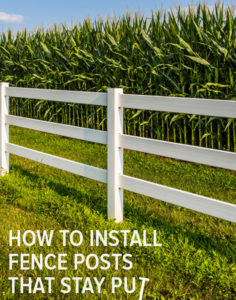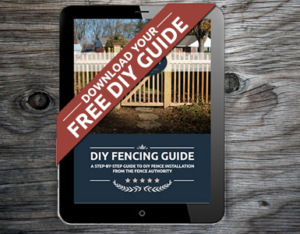How to DIY Fence Posts that Stay Put

When you take on a DIY fence installation project, a lot of decisions are left entirely up to you. This is great if you already know what to do, but not if you’re stuck wondering which installation method to choose. One of the most important installation decisions to make is how to set your fence posts in the ground. Without secure posts, your fence won’t stand much of a chance against the elements! Let’s explore how to ensure your fence posts stay put.
Choosing the Strongest Posts for Your DIY Fence
No matter what type of DIY fence you install, you don’t want weak posts. Wind and gravity will take hold of them, and they’ll start tipping over.
Some types of fences have a greater risk of tipping and therefore require extra care in post installation. Full privacy fences are the most likely to incur damage from wind because they are solid. With no way for wind to pass through, your panels essentially act as wind sails–and they’re held down by only two posts every eight feet or so! Basically, the more surface area your fence has, the harder it will be for your posts to hold it up. Split rail fences have an easier time in the wind because of their sparse rails.
Fence posts should be buried sufficiently deep in the ground. Between a half and third of the post is a good standard. If you’re installing a panel fence, you may want to consider supporting your fence with thicker posts. When it comes to panels, more surface area is bad, but with your posts, you want more surface area! A skinny fence post–especially one supporting a solid panel privacy fence–cannot easily withstand the raging winds. When you dig your post holes, make sure they are three times the width of your fence post.
Proper Fence Post Installation: Should You Use Gravel or Concrete?
Once you’ve chosen the fence posts you want, how exactly do you install them so they stay put? Methods vary, and opinions differ. Some fence posts are set in concrete while others are set in gravel, and you need to decide which method you’ll use for your own fence. Concrete is a stronger material than gravel, yet there are pros and cons of both.
Installing Fence Posts in Crushed Gravel
Even when they’re installed as securely as possible, fence posts mounted in the ground are at risk of moisture damage as rainfall wets the ground and seeps below. The main advantage of crushed gravel is that it drains moisture away from the post. The bits of gravel interlock to mimic the strength of concrete, and many DIYers also choose gravel because it is much easier to remove if you decide to take down your fence. However, gravel cannot always take the place of concrete–and the more secure your fence is, the less likely you are to end up wanting to remove it! If you’re already thinking about taking your fence down, you may want to pick a project that makes you a little more excited for the future of your fence.
Setting Fence Posts in Concrete
Concrete is the most secure material for setting fence posts, especially if you have sandy soil. Gravel may be okay with dense, clay-heavy soil, but in looser soil, concrete is the only thing that will truly keep your fence posts stuck in place. Using premixed concrete rather than dry concrete will ensure ultimate security.
While concrete is sturdy, it lacks the drainage of gravel and can trap moisture, ultimately leading to rot. To combat this problem, when you pour your concrete, fill the hole so that the top of the concrete forms a slight dome. This will enable water to run off the post hold and away from the wooden post. It is also important that your concrete is buried beneath the dirt rather than sticking out of the ground.
Don’t Settle for Fence Posts You Can’t Trust
Try not to skimp on any aspect of installation–even if seems easier in the short term. Proper fence post installation is absolutely crucial for a successful DIY project! If you don’t feel confident in your ability to install sturdy posts, professional fence installation may be your best bet.
Take these considerations into account and install your fence posts properly, and your fence will be guaranteed to last.
Need step-by step instructions for installing your fence? Just download the handy DIY Fencing Guide!
To order fence parts or schedule professional installation,
call 800-431-4303 or contact us online!



7 Comments
Your blog is very impressive. Thanks for sharing your great landscaping ideas with us. I was looking some great landscaping design.
If you want the fence to stay put, be sure to avoid some common
problems.
Usually, wet rot is the type that will most likely appear on your fence. You will notice it at the base of the fence. This is the area that will be most affected. You’ll see cracking or softening of the timber, there may also be visual fungus or a damp smell. However, if you live in a harsh, dry environment, elements of dry rot can be visible in cracking or crumbling wood.
I am in Texas, heavy clay soil here. Everyone’s fence is leaning either from wind or the clay soil. I am thinking of doing a really solid fence with redwood 6×6 posts (I used to live in California and really miss the redwoods). I am thinking of using 48″ quickcrete forms with concrete and a galvanized steel post base, then mounting the redwood on top of that. Any ideas if the posts will tilt or move?
Is it wise to use both gravel and cement when installing post?
I didn’t know that a full property fence is more likely to incur damage from wind. My cousin is wanting to install a new gate and needs to find a company to help her. Hopefully, she can find a nice one that will get her the gate she needs.
I installed eight foot high wood privacy fence with 12 foot 4×4 with 2 x 4 cross pieces and 1 x 4 fencing in 1990 all posts cemented in…..total of 170 feet.. slowly over the years concrete has cracked and fence has leaned.. almost all posts are loose… 2014 took out t he back 48 feet posts came out easy cement came off easy posts were still in good shape considering wet ground….. put tar on the bottom 3 1/2 feet of it then covered with a plastic post cover then put it on top of 3 inches of gravel and tamped gravel around it … nice and solid. last year a tree fell on the fence took out 4 feet of fencing and 3 two by fours but the post never budged… I think gravel packed is better then ground and cement….
Informative post, Thanks for sharing with us.
Please update more post related wooden fence posts